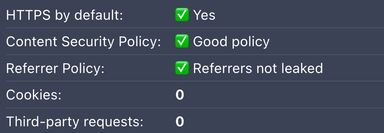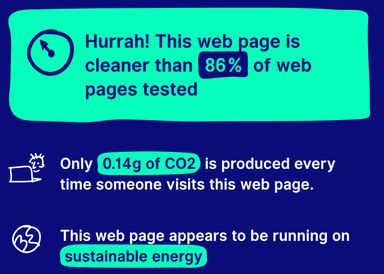Sustainable web is all about simplicity and bringing the creation of websites back to the original idea of creating value as simply as possible with as few hurdles as imaginable. A website is sustainable when it provides value for its owner and its users for a long time, and without harming the users or the world. These are big words, but sometimes big words are necessary to describe something important.
These seven aspects – maintained over time and through constantly changing conditions and content – determine the sustainability of a website:
- User Experience (UX)
- Usability
- Accessibility
- Performance
- Integrity
- Security
- CO2 efficiency
Some of these are hard to assess and measure since they consist of complex and subjective parameters that need human judgment to evaluate. But they often overlap, and some are proxies for others, so there is good reason to think that quality in some aspects indicates a responsible approach to the big picture. You can get a pretty good idea of where you stand by doing a few simple tests with free tools.
Without further ado, here are three easy ways to test the quality of your website!
1. Google PageSpeed Insights
Link: https://pagespeed.web.dev/

Google PageSpeed Insights is a great place to start inspecting your website. It will give you a 0-100 grade on Performance, Accessibility, Best Practices and SEO. 90+ is considered "green" by Google, but we think you should aim higher and go for 95+ on Performance and 100 for the rest.
2. Webbkoll
Link: https://webbkoll.dataskydd.net/en

Webkoll is a tool that audits your website for integrity and security. It looks for cookies, referrals to third parties and a number of security related aspects. All the tests should be green with no or few referrals to third parties. If there are referrals to third parties and you live in Europe, those third parties should be EU companies.
3. Website Carbon Calculator
Link: https://www.websitecarbon.com/

Webperf, for websites of public interest in Sweden
Do you represent a public sector organization in Sweden? Then, someone has already done the job for you! Webperf recurringly runs comprehensive tests on a large number of public sector organizations' websites in Sweden, scores them and ranks them. To see if Webperf’s tests cover your website, go to https://webperf.se/search/ and search for it. There are some exceptions where non public sector company websites are tested, for example the category "Web agencies and digital consultants" where we at factor10 are ranked. Here is that category on Webperf: https://webperf.se/category/webbyraer/.
And now what?
Have you done the tests above? Most things look okay, high numbers where they should be high and low where they should be low? Congratulations! Your website is probably as sustainable as you want it to be!
Are you in doubt? Not sure how serious the problems are? Assessing problems and comparing them against each other, and prioritizing from a holistic perspective is a job for human judgment and, ultimately, a matter of how important it is for you to have a sustainable website. We would love to help. We take pride in sustainable web and can advise from a holistic perspective, considering all seven aspects.
Read more about our offering, Sustainable web.
If you would like to know more about sustainable web, and discuss what you could do to improve the quality of your website, don't hesitate to contact us today!
Photo by Johen Redman on Unsplash.
